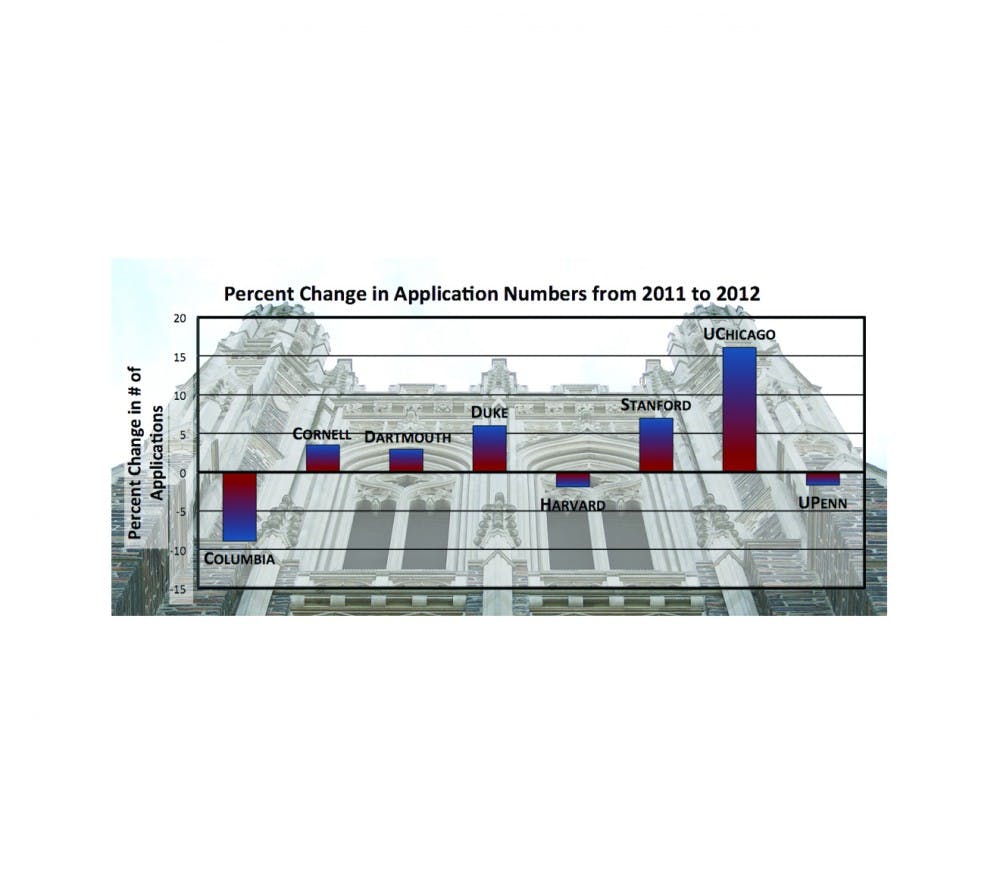Some discrepancies in the rise and fall of application rates at top institutions follow a distinct geographical divide.
Although Duke admissions saw a 6 percent increase in the total number of applications from last year, some elite institutions have reported a decrease in applications for the Class of 2016. Dean of Undergraduate Admissions Christoph Guttentag attributed the varying admissions trends to a regional divide, with schools in the Northeast receiving less applications than in past years.
“We are approaching a point where the number of high school students is declining, and this phenomenon is happening at a much quicker rate in the Northeast,” Guttentag said. “It’s not surprising that universities in the northeastern region are significantly more affected than those that are outside of the region.”
Duke received a record high number of early and regular applications at 31,565. Several other schools’ application rates also rose—Northwestern University experienced a 3.5 percent increase in applicants, and the University of Chicago saw a 16 percent increase. Applications to Stanford University rose nearly 7 percent.
But in the Northeast, many institutions saw a decline. Applications fell approximately 2 percent at the University of Pennsylvania, 2 percent at Harvard University and 9 percent at Columbia University.
Reaching the potential
Compared to other institutions, getting into Duke may seem more feasible to students.
As university admit rates enter single digits, applicants are becoming more realistic about their chances of getting into certain schools, Guttentag said. He added that prospective students from a few decades ago would have viewed Duke’s current admit rate—13 percent—as completely unreasonable, but current applicants have recalibrated their expectations of reasonable admit rates.
Additionally, Duke received a greater proportion of applications from domestic students compared to recent years, said Anne Sjostrom, associate director of international undergraduate admissions. Guttentag noted that this trend is indicative of Duke’s rising popularity among American high school students, relative to the University’s peers in the Northeast.
“Even as [the University’s] admit rate approaches the 10 percent mark, we have not yet met our potential in terms of appealing to a broad range of students,” Guttentag said. “As more students reflect upon what kind of college experience they hope to have and prioritize such expectations, Duke will become appealing to more of these applicants.”
Jeremy Manier, news director at the University of Chicago, wrote in an email Tuesday that despite the school’s surge in applicants, the number of applications in the current cycle is still lower than some universities in the Northeast. He added that there is a logical limit to growth for each university and, like Duke, the University of Chicago is still in the process of expanding its reach.
A period of ‘greater stability’
Despite the University’s increased application numbers, its yield rate—the number of students accepted who choose to matriculate—may stay the same.
Guttentag noted that because other institutions have not experienced a significant increase in applicants, there is the likelihood that these universities will admit the same applicants as Duke—meaning that top students will receive multiple offers. He added that the competition to attract these strong candidates to the University will be tougher for Duke than in recent years.
Duke’s surge in applications is “anomalous to some degree,” Guttentag said, noting its resistance to certain changes in the current admissions cycle. This Fall, Harvard and Princeton University both reinstated nonbinding early admissions programs, a move that Guttentag said did not affect the number of applicants to Duke.
Declining applicants is not universal among northeastern schools—Dartmouth College saw a 3 percent increase in applications, and Cornell University saw a 3.5 percent increase—and even among institutions with fewer applicants, some admissions directors view the plateau as a positive sign.
William Fitzsimmons, the dean of admissions and financial aid at Harvard, wrote in The New York Times’ “The Choice” college admissions blog that he viewed the tapering in applications as an indicator that the college admissions process is entering a period of “greater stability and less frenzy.”
In response, Guttentag underlined the need for predictability in college admissions, noting that applicants, parents and guidance counselors want to go through the admissions process with an understanding of their chances of being admitted. If the number of applications begins to stagnate or even diminish, universities will allow students and their families to better plan the admissions process.
Even as the number of applications continues to soar, Guttentag emphasized the importance of recruiting prospective applicants.
“Duke has a wonderful visibility, and we love to take advantage of it,” Guttentag said. “But many prospective students and parents have a limited view of what Duke is about, and it is our duty to educate the new batch of high school seniors each year.”
Get The Chronicle straight to your inbox
Signup for our weekly newsletter. Cancel at any time.

